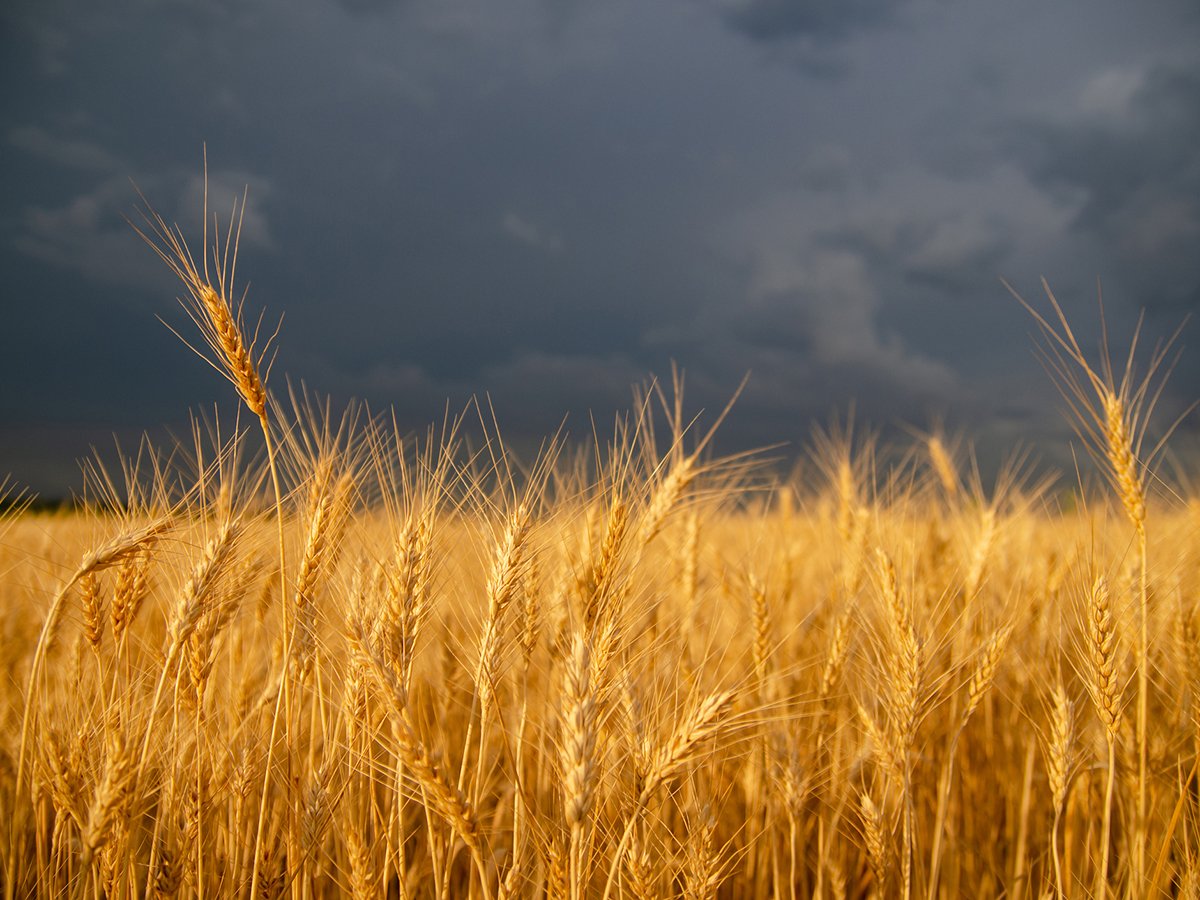Help for new mothers
Bringing children into the world is an important job. It is to our benefit that groups such as Motherisk are becoming pillars for mothers all across Canada.
The group is aimed at expectant and nursing mothers, and since 1985, Motherisk has counseled more than 100,000 women, their families and physicians. Callers have sought information about the reproductive risk or safety of hundreds of medications, drugs, herbal remedies, chemicals, radiation and maternal infections. Through specialized counselling and research, Motherisk has helped to ensure:
- Rational treatment for women in pregnancy and while breastfeeding.
- A healthy start for unborn children.
Read Also

Late season rainfall creates concern about Prairie crop quality
Praying for rain is being replaced with the hope that rain can stop for harvest. Rainfall in July and early August has been much greater than normal.
During my pregnancy I developed a high fever and was concerned about what medication I could take. If you have questions about taking acetaminophen for your headache, a cold medication for that stuffy nose, whether to have another cup of coffee or what paint to use in the nursery, you can ask Motherisk.
The service’s information line is 416-813-8084, HIV healthline
1-888-246-5840, morning sickness helpline, 1-800-436-8477 and website at www.motherisk.org.
For dill fanciers
TEAM has received several requests for a dill pickle recipe that was provided several years ago in the I’d Like to Know column. Emmie Oddie recommended this recipe in the Sept. 24, 1992 issue.
Classic dill pickle
15 four-inch 15
(10-cm) cucumbers
11Ú2 cups pickling 375 mL
vinegar
41Ú2 cups water 1.12 L
1Ú3 cup pickling 75 mL
salt
1Ú3 cup sugar 75 mL
For each jar:
1 clove of garlic 1
1 sprig fresh dill 1
or 1Ú2 teaspoon 2 mL
dill seed
Wash cucumbers and remove blossom ends.
Fill water bath canner with hot water. Place three one-quart (one L) preserving jars in canner over heat to sterilize. Boil jars at least 15 minutes. Place metal snap lids in boiling water and boil five minutes to soften sealing compound. Keep hot until ready to use.
Combine vinegar, water, pickling salt and sugar in a Dutch oven. Bring to a boil.
Pack cucumbers firmly into hot sterilized jar, leaving a three-quarter inch (two cm) headspace. Add one clove of garlic and sprig of fresh dill or 1Ú2 teaspoon (two mL) dill seed in each jar. Ladle brine over cucumbers. Leave a quarter inch (six mm) headspace.
Clean jar rim. Centre metal snap lid. Apply screw band just until fingertip tight. Place in canner. Repeat with remaining jars.
Adjust boiling water level to one inch (2.5 cm) above jar tops. Cover canner.
Begin process time immediately, and process 20 minutes in a simmering water bath.
Remove jars from canner. Set upright and space apart out of drafts to cool. Cool 24 hours. Test for seal. (Sealed lids curve downward in the centre.) Wipe jars, label and date. Store in cool, dark location.
Yield: Three one-quart (one L) jars.
This recipe was developed and tested by Food Pro 92 in Saskatoon.
Tangy recipes
Dear TEAM: I am looking for a recipe for a tangy dill relish. I am also looking for a roast recipe which has gingersnaps and horseradish in the gravy. I believe it appeared as a winning entry in a contest of the March/April 1991 issue of Country Woman magazine. Does anyone have it? – H.S., from Sask.
Dear H.S.: This is a favorite family recipe for a tangy green relish. It goes well with hamburgers, hotdogs as well as cold meats in a sandwich. The original does not contain dill, but the consensus is that it would be a tasty addition.
7 large cucumbers
2 large onions
green pepper
(red peppers can be
used also)
Put 1Ú4 cup (50 mL) coarse salt through a grinder (or food processor). Grind cucumbers and put in a large bowl. Sprinkle with salt and let stand overnight. Drain and rinse the next day.
Sauce:
3 cups sugar 750 mL
3 cups vinegar 750 mL
3Ú4 teaspoon turmeric 4 mL
1 cup water 250 mL
1Ú2 cup flour 125 mL
pinch of celery salt
pinch of red pepper
pinch of mustard seed
Note: It is best to mix the water and flour together before adding to the other ingredients.
Stir the sauce ingredients together in a large heavy pot on medium heat until they come to a boil. Boil until thick, stirring occasionally. Add cucumbers, onion and pepper, return to a boil. Continue boiling for another 10 minutes, again stirring occasionally. Pour into hot sterilized jars to within one-quarter inch (six mm) of top. Seal.
Variations:
- Add 1Ú2 teaspoon (two mL) of cayenne pepper.
- Add 1Ú2 teaspoon (two mL) ginger.
- Add dill weed for extra flavor.
To address your second question, I researched some issues of Country Woman but came up with nothing. I then faxed the publisher of the magazine and they also could not find the recipe that you are searching for. They told me about their sister magazine Taste of Home and I found something close to your request.
Old world sauerbraten
Sent to the magazine by Phyliss Berenson, Cincinnati, Ohio.
2 tablespoons 30 mL
cooking oil
1 beef roast 1
5-6 pounds (2.25-3 kg)
2 onions, sliced 2
1 cup vinegar 250 mL
2 cups water 500 mL
1Ú4 cup lemon juice 50 mL
3 bay leaves 3
6 whole cloves 6
2 teaspoons salt 10 mL
1Ú2 teaspoon pepper 2 mL
5 tablespoons 75 mL
ketchup
12 gingersnaps, 12
crumbled
In a Dutch oven, heat oil over medium heat. Brown beef on all sides. Add all remaining ingredients except gingersnaps; bring to a boil. Reduce heat; cover and simmer until the beef is tender, about three hours. During the last 30 minutes, stir in gingersnaps. Remove meat; discard bay leaves and cloves. While slicing meat, bring gravy to a boil to reduce and thicken.
Yield: 14-16 servings. You could serve the beef with horseradish, if you desire.
If any of the readers have a recipe for H.S. that contains horseradish in the gravy we would love to hear from you.
Cleaning woodwork
Dear TEAM: I read your column and enjoy it. Now I have run into a problem in cleaning varnished woodwork. On my dark doors it looks whitish if I wash or even rub it with soapy water. – S.R., Olds, Alta.
Dear S.R.: Here are three easy cleaning recipes to try on your woodwork:
- All purpose cleaner – Mix together in a one gallon (four L) container, one tablespoon (15 mL) baking soda, 1Ú4 cup (50 mL) vinegar, 1Ú4 cup (50 mL) household ammonia and fill the rest with hot water. Use in an old pump spray container.
Caution: Never mix household ammonia with bleach, as the mixture creates a poisonous gas.
- The old standby – 1Ú2 cup (125 mL) vinegar to four cups (one L) of warm water.
- Furniture polish for woodwork that has been varnished, lacquered or shellacked – Mix 12Ú3 tablespoons (25 mL) olive oil, one tablespoon (15 mL) white vinegar, and four cups (one L) warm water and pour into a spray container.
This polish works best when warm; heat by letting the bottle sit in a pan of hot water. After applying, rub dry with a cloth.
P. 68 & 69: COOKING FOR CONVENIENCE
By Liz Delahey
MISSASKQUAHTOOMINA
Saskatoons, saskatoons
It’s time to celebrate this year’s great saskatoon harvest with new recipes for the frozen berries tucked in your freezer. If they were not plentiful in your region, perhaps you are lucky enough to have a commercial grower nearby where you can buy frozen berries.
Wild saskatoons have been eaten on the Prairies for centuries as First Nations people used them with dried buffalo meat to flavor the pemmican they packed on the trail and as a welcome addition to bannock. Early settlers recognized the potential to diversify their diets with this delicious fibre-rich berry, which also is a relatively good source of calcium, potassium, copper and carotene and an excellent source of manganese, magnesium and iron.
The berry’s name is derived from the Cree Mis-sask-quah-toomina. According to a member of the
original surveying party for the townsite of Saskatoon, First Nations people used to gather quantities of the berries and walk through the camps calling what sounded to members of the survey party like “saskatoons, saskatoons.”
Wild saskatoons grow along riverbanks, coulees and bluffs. A good way to spot them before the picking season in July is to watch for patches of white blossoms that appear in May before the chokecherries bloom. As more land is cleared, it becomes more difficult to find the native berries but fortunately there are commercial growers who operate U-picks or sell the berries, as well as processors who create products including jams, jellies, spreads, chocolates and wine.
Saskatoon bushes can be grown from seeds, root sprouts, root cuttings or softwood cuttings. They should be planted in sites not subject to late spring frosts but will grow in all types of soil except poorly drained clay soils lacking in humus. They begin to bear fruit when they are two to four years old on the previous year’s growth and on older wood.
The berries vary in size and sweetness according to location, seasonal conditions and the variety. Some bloom and bear fruit earlier than others.
Barely ripe berries are considered the best for jams and jellies because they contain more pectin. Tartness can be created by combining them with rhubarb. This option also creates a juicier pie. Just combine one cup (250 mL) of finely chopped rhubarb with three cups (750 mL) saskatoons, 3Ú4 cup (150 mL) sugar and 1Ú4 cup ( 50 mL) flour for a pie filling.
Lemon juice is also a good flavor enhancer for saskatoons, giving a desirable tartness to baked goods, such as muffins. Wild saskatoons often have a faint almond flavor that can be emphasized with about 1Ú4 teaspoon (1 mL) of almond extract.
Quickie Saskatoon Pie
This recipe from the Saskatchewan Sportsman’s Guide written by Henrietta Goplen substitutes a graham wafer crust for traditional pie pastry. The filling can be used for either type of crust.
CRUST:
12Ú3 cups (400 mL) GRAHAM WAFER CRUMBS
1Ú2 cup (125 mL) BUTTER OR MARGARINE
1 tbsp. (15 mL) ICING SUGAR
SALT
FILLING:
4 cups (1 L) SASKATOONS
1 tbsp. (15 mL) LEMON JUICE
2 tbsp. (30 mL) WATER
1-2 tbsp. (15-30 mL) MINUTE TAPIOCA
1 cup (250 mL) SUGAR
For graham crust: Soften butter and mix with other ingredients. Pat into 10-inch (25cm) pie plate.
For saskatoon filling: Place thawed berries in saucepan, add water and lemon juice. Simmer about 10 minutes (do not boil). Add sugar and tapioca and let cool. Place filling in graham crust and chill.
Serve with whipped cream, or ice cream.
For traditional pastry: Place the filling in pastry-lined pie plate and dot with one tablespoon (15 mL) butter. Cover with top crust and seal edges. Brush top crust lightly with milk, then sprinkle with sugar and make slits in crust. Bake at 425 F (220 C) for 15 minutes and then at 350 F (180 C) about 35 minutes longer.
Saskatoon Berry Poppy Seed Coffee Cake
2Ú3 cup (150 mL) SUGAR
1Ú2 cup (125 mL) BUTTER (room temperature)
2 tsp. (10 mL) GRATED LEMON PEEL
1 EGG
11Ú2 cups (375 mL) FLOUR
2 tbsp. (30 mL) POPPY SEEDS
1Ú2 tsp. (2 mL) BAKING SODA
1Ú4 tsp. (1 mL) SALT
1Ú2 cup (125 mL) SOUR CREAM
FILLING;
2 cups (500 mL) SASKATOONS
1Ú3 cup (75 mL) SUGAR
1Ú4 tsp. (1 mL) NUTMEG
2 tsp. (10 mL) FLOUR
GLAZE:
1Ú3 cup (75 mL) ICING SUGAR
1-2 tsp. (5-10 mL) LEMON JUICE
Grease and flour bottom and sides of a 9 or 10 inch (23 or 25 cm) spring form pan. In a large bowl beat the sugar and butter until light and fluffy. Add lemon peel and egg. Beat two minutes at medium speed.
In a medium bowl combine flour, poppy seeds, baking soda and salt. Add to butter mixture alternately with sour cream. Spread batter over bottom and one inch (2.5 cm) up the sides of the pan, making sure batter on the sides is at least a quarter inch (0.5 cm ) thick.
Combine filling ingredients. Spoon over batter. Bake at 350 F (180 C) 45 to 55 minutes or until crust is brown. Cool slightly. Remove sides of pan.
For glaze, combine icing sugar and enough lemon juice to make glaze of drizzling consistency. Blend until smooth. Drizzle over coffee cake. Serve warm or cold.
Makes eight servings.
Saskatoon Berry Pie
When seven food writers and a photographer from Central Canada visited Saskatoon in July as guests of the Canola Information Service, one of their “fun” assignments was to prepare a saskatoon berry pie with canola oil pastry.
Each food writer was assigned a canola mentor, who acted as a personal guide throughout the event. It included a farm tour, as well as sessions at the Agriculture Biotechnology Information Centre and the POS Pilot Plant and introductions to prairie food and culture.
Mentors and writers collaborated on the saskatoon pie assignment using the following recipe.
CANOLA OIL PASTRY:
13Ú4 cups (425 mL) ALL-PURPOSE FLOUR
1 tsp. (5 mL) SALT
1Ú2 cup (125 mL) CANOLA OIL
3-4 tbsp. (45-60 mL) ICE WATER
Measure flour and salt into a bowl. Add canola oil. Mix together until particles are the size of small peas. Sprinkle with water one tablespoon (15 mL) at a time, mixing until the flour is moistened and the dough almost lifts from the side of the bowl.
If the dough seems dry, add one or two tablespoons (15-30 mL) canola oil. Do not add additional
water. Gather dough.
Press firmly into ball and divide into two rounds. Flatten each round between two sheets of wax paper. Wipe counter with damp cloth to prevent slippage. Roll pastry two inches larger than inverted pie plate. Peel off top paper. Place pastry paper side up in pan. Peel off paper. Ease pastry loosely into position. Trim edge of pastry. Add filling. Roll top crust and place over filling. Cut slits. Trim edge of pastry one inch (2.5 cm) from rim of pan. Fold under bottom crust even with pan and flute to seal edges.
Bake on bottom rack of oven at 425 F (220 C) for 15 minutes, then reduce heat to 350 F (180 C) for another 30 to 35 minutes until juice is bubbly.
PIE FILLING:
4 cups (1 L) SASKATOONS
1 tbsp. (15 mL) LEMON JUICE
2Ú3 cup (150 mL) SUGAR
1Ú4 cup MINUTE TAPIOCA
(50 mL or less) OR FLOUR
Exact proportions of fruit vary with juiciness of the saskatoons and personal preference regarding
sweetness and thickness of filling.
Combine saskatoons, lemon juice sugar and minute tapioca or flour in a large bowl.
Arrange mixture in unbaked pie shell and bake as indicated above.
Saskatoon Rhubarb Jam
This recipe from an Alberta Agriculture pamphlet has no added pectin. It worked well for me using slightly under-ripe berries. If you want to use commercial pectin for your jam follow instructions for blueberries or call a pectin help line for recipes.
6 cups (1.5 L) SASKATOONS
4 cups (1 L) DICED RHUBARB
1Ú2 cup (125 mL) WATER
6 cups (1.5 L) SUGAR
Crush saskatoons with potato masher. Do not use food processor. Combine rhubarb with water in large heavy saucepan and bring to boil. Simmer (covered) about five minutes or until rhubarb is soft. Stir in crushed saskatoons and bring to a rolling boil.
Meanwhile, warm sugar in 200 F (100 C) oven. Then slowly add to hot fruit. Continue boiling for 10 minutes uncovered or until a spoon of jam quickly cooled in the freezer has the desired
consistency. Ladle into sterilized jars and seal with snap lids.
Lemony Saskatoon Muffins
11Ú2 cups (375 mL) ALL-PURPOSE
FLOUR
1Ú2 cup (125 mL) SUGAR
21Ú2 tsp. (12 mL) BAKING POWDER
1Ú4 tsp. (1 mL) SALT
1Ú4 tsp. (1 mL) NUTMEG
1 cup (250 mL) SASKATOONS
1 EGG
1Ú4 cup (50 mL) CANOLA OIL
3Ú4 cup (175 mL) MILK
TOPPING:
1 tbsp. (15 mL) LEMON RIND
2 tbsp. (30 mL) SUGAR
Into a medium bowl sift flour, sugar, baking powder, salt and nutmeg. In separate bowl mix egg, oil and milk, make a well in dry ingredients and add liquid mixture.
Mix only until dry ingredients are moistened. Spoon batter into large paper-lined muffin tins. Top each muffin with topping mixture.
Bake at 425 F (220 C) for 15 minutes or until nicely browned. Makes about 10 large muffins.
Muffins are an ideal treat for summer picnics and school lunches.
















